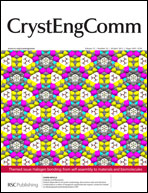The Cu2(3-Ibz)4(L)2 paddlewheel unit (3-Ibz = 3-iodobenzoate) has been synthesised with a series axial ligands L, that are either nonlinear (L2 = pyrimidine), asymmetric (L = 2,6-dimethylpyrazine, 3-cyanopyridine, 4-cyanopyridine) or hydrogen bond-enabled (L = nicotinamide, MeOH). The crystal structures of these compounds have been used to investigate the potential competition or cooperation between coordination bond, halogen bond and hydrogen bond formation in the propagation of network structures comprising these building blocks. In all but one example the paddlewheel unit was formed. Propagation of the resulting networks via the axial ligand results in hydrogen-bonded networks where strong hydrogen bonding groups are available, but in other cases leads to a coordination network, a halogen-bonded network, or a network propagated via π–π interactions. In all but two of the seven crystal structures reported halogen bonds involving the iodobenzoate ligands are formed, typically propagating networks in orthogonal directions to that involving the axial ligands.
![Graphical abstract: Coordination chemistry meets halogen bonding and hydrogen bonding: building networks from 3-iodobenzoate paddlewheel units [Cu2(3-Ibz)4(L)2]](/en/Image/Get?imageInfo.ImageType=GA&imageInfo.ImageIdentifier.ManuscriptID=C3CE26890J&imageInfo.ImageIdentifier.Year=2013)
You have access to this article
 Please wait while we load your content...
Something went wrong. Try again?
Please wait while we load your content...
Something went wrong. Try again?
![Graphical abstract: Coordination chemistry meets halogen bonding and hydrogen bonding: building networks from 3-iodobenzoate paddlewheel units [Cu2(3-Ibz)4(L)2]](/en/Image/Get?imageInfo.ImageType=GA&imageInfo.ImageIdentifier.ManuscriptID=C3CE26890J&imageInfo.ImageIdentifier.Year=2013)

 Please wait while we load your content...
Please wait while we load your content...